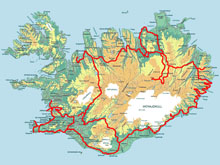Iceland 1999 Overview
Air, water, earth and fire. The elements are the primordial ones, kept pure in their original physical essence. However in Iceland, land of ice and fire, these elements live together with all their spectacular contrasts and create one of the most disconcerting geographical paradoxes.
Iceland map is dotted by large white spots that alone cover the 11% of the entire island.
These white spots are called jökull in Icelandic and they are the wide glaciers such as the round caps of Drangajökull, Myrdaljökull, Langjökull and Vatnajökull.
The last one covers by itself 8.400 square kilometers and is the largest ice field in Europe.
Most of Iceland is curiously located on the Mid-Atlantic Ridge and its volcanic origin can be seen simply overlooking its landscape: barren dunes, rocky mountains and lava pits.
On 14th November 1963, when through rumbles and smoke columns, a new island, Surtsey, began to rise from the south-coast sea, Icelandic inhabitants could watch, as a film, the origin of their country. The “construction” of Surtsey last three years, Iceland one is still current.
Iceland today has 30 active volcanoes and the eruptive activity is still continuous. The island is also scattered with all the geological-related phenomenons: geysers, steaming fumaroles, hot springs, boiling mud. Much of the island is heated by geothermal heat, generated by hot springs.
The more you know all these peculiar features, the better you get aware that Iceland is an obliged destination for all the adventurous souls.
For all of these peculiar features, and many others, we can say that Iceland is an obliged destination for all the adventurous souls.
Our adventure took place from 14th to 29th August 1999.
We decided to realise a self-made travel – only the flight and the first night in the capital have been booked in advance; for the next nights we found accommodations at the various youth hostels around Iceland.
Starting at Reykjavík, we drove around Route n°1, anti-clockwise for the first part of the trip and clock-wise for the other.
The pictures, presented here, are from that period.






